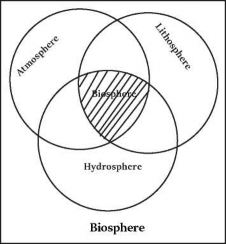1.3.6. Biosphere
Biosphere is a part of the earth where life can exist. Biosphere represents a highly integrated and interacting zone comprising of atmosphere (air), hydrosphere (water) and lithosphere (land).

It is a narrow layer around the surface of the earth. If we visualise the earth to be the size of an apple the biosphere would be as thick as its skin.
Life in the biosphere is abundant between 200 metres (660 feet) below the surface of the ocean and about 6,000 metres (20,000 feet) above sea level.
Biosphere is absent at extremes of the North and South poles, the highest mountains and the deepest oceans, since existing hostile conditions there do not support life. Occasionally spores of fungi and bacteria do occur at great height beyond 8,000 metres, but they are not metabolically active, and hence represent only dormant life.
The energy required for the life within the biosphere comes from the sun. The nutrients necessary for living organisms come from air, water and soil. The same chemicals are recycled over and over again for life to continue.
Living organisms are not uniformly distributed throughout the biosphere. Only a few organisms live in the polar regions, while the tropical rain forests have an exceedingly rich diversity of plants and animals (50% of Global Biodiversity).
Do you know?
Environmental Information System (ENVIS), a Central Sector Scheme of the Ministry has been implemented since 1982. The purpose of the scheme is to integrate country-wide efforts in environmental information collection, collation, storage, retrieval and dissemination through ENVIS websites, which are dedicated to different interesting themes.
